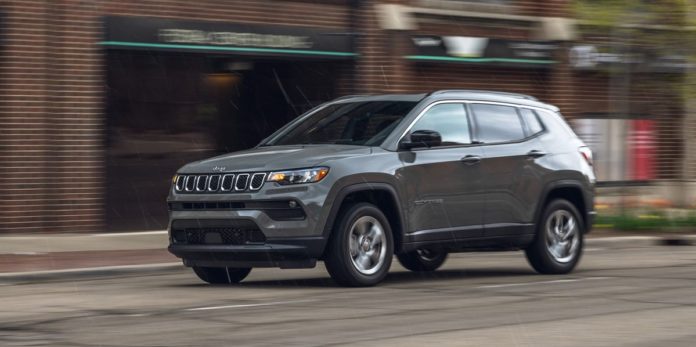When Jeep refreshed its subcompact Compass last year, we applauded its evolution. The exterior took the shape of a junior Grand Cherokee. Its interior, no longer a penalty box lined with inexpensive-looking materials, provided a ritzier feel and appeal. Despite that progress, the languid powertrain carried over, and thus the Compass failed to gain meaningful ground on the competition in the hotly contested segment.
For 2023, Jeep has tossed the 2.4-liter inline-four in the dumpster where it belongs. In its place is a more desirable turbocharged 2.0-liter inline-four, similar to that which can be had in the Jeep Wrangler. Here in the Compass, the turbo four makes 200 horses and 221 pound-feet, gains of 23 and 49, respectively, over the former naturally aspirated mill. More importantly, peak torque arrives at 1750 rpm compared to 3900 in the 2.4-liter.
In other driveline news, the ratio-hunting nine-speed automatic is now in the rearview, and an eight-speed autobox manages the shifting duties. Torque is delivered to all four contact patches, as all-wheel drive is now standard.
At the track, the turbocharged Jeep Compass runs all over its naturally aspirated predecessor. With a 7.5-second sprint to 60 mph, the 2023 Compass hits the mark 1.8 seconds quicker than before. Its quarter-mile performance is improved by 1.3 seconds, now taking 15.8 seconds and crossing the line at 89 mph. During more common driving scenarios, in both the 30-to-50-mph (4.4 seconds) and 50-to-70-mph (5.4 seconds) passing tests, improvements of 0.6 and 1.1 seconds, the 2.0-liter’s extra muscle paired with fewer ratios for the transmission to juggle gets the Compass around slower traffic with far less effort.
During a cold start, the turbocharged 2.0-liter is a groaning little thing, settling into a 43-decibel thrum after it warms up—1 decibel louder than before. But mash the throttle and push the tachometer to the 6200 rpm redline and just 70 decibels enter the cabin, a marked improvement of 4 decibels over the old 2.4-liter.
Underway, the Compass remains relatively composed when leaned on, delivering a middling 0.81 g of grip from its 225/60R-17 Firestone Destination LE2 all-season rubber. On the open road, however, the Compass requires undue attention, owing to the steering’s spongey on-center feel. When it’s time to slow things down, the firm but overly sensitive brake pedal is difficult to smoothly modulate, and stops from 70 mph require a lengthy 195 feet.
Despite the newfound power and quicker acceleration, fuel economy improves over the old powertrain. According to the EPA, the Compass earns ratings of 24 mpg city, 32 mpg highway, and 27 mpg combined, improvements of 2 mpg across the board. We observed 23 mpg in a mix of highway and city driving.
While the pepped-up Compass still trails behind the 250-hp Ford Escape and the 256-hp Mazda CX-5 Turbo in both acceleration and cargo area, its attractive starting price of $29,995 is well below those two. Naturally, the price increases as you navigate up through the eight trim levels, topping out with the High Altitude for $40,930. No matter where in the lineup you settle, the powertrain is what puts the Compass back on the map.
Specifications
Specifications
2023 Jeep Compass 4×4
Vehicle Type: front-engine, all-wheel-drive, 5-passenger, 4-door wagon
PRICE
Base/As Tested: $29,995/$41,270
Options: Latitude trim, $3995; Sun and Sound group (Alpine stereo, panoramic roof), $2695; Convenience group (remote start system, auto dimming rearview mirror, heated steering wheel and front seats, wiper de-icer, eight-way power driver seat, power liftgate), $2095; Driver Assistance group (adaptive cruise control, surround-view camera system, inductive charging pad, automatic wipers), $1895; Sting-Gray Clearcoat paint, $595
ENGINE
turbocharged and intercooled DOHC 16-valve inline-4, aluminum block and head, direct fuel injection
Displacement: 122 in3, 1995 cm3
Power: 200 hp @ 5000 rpm
Torque: 221 lb-ft @ 1750 rpm
TRANSMISSION
8-speed automatic
CHASSIS
Suspension, F/R: struts/multilink
Brakes, F/R: 12.0-in vented disc/10.9-in disc
Tires: Firestone Destination LE2
225/60R-17 99T M+S
DIMENSIONS
Wheelbase: 103.8 in
Length: 173.4 in
Width: 73.8 in
Height: 64.6 in
Passenger Volume, F/R: 52/47 ft3
Cargo Volume, Behind F/R: 60/27 ft3
Curb Weight: 3717 lb
C/D TEST RESULTS
60 mph: 7.5 sec
1/4-Mile: 15.8 sec @ 89 mph
100 mph: 20.8 sec
Results above omit 1-ft rollout of 0.3 sec.
Rolling Start, 5–60 mph: 7.9 sec
Top Gear, 30–50 mph: 4.4 sec
Top Gear, 50–70 mph: 5.4 sec
Top Speed (C/D est): 118 mph
Braking, 70–0 mph: 195 ft
Roadholding, 300-ft Skidpad: 0.81 g
C/D FUEL ECONOMY
Observed: 23 mpg
EPA FUEL ECONOMY
Combined/City/Highway: 27/24/30 mpg
C/D TESTING EXPLAINED
Senior Testing Editor
David Beard studies and reviews automotive related things and pushes fossil-fuel and electric-powered stuff to their limits. His passion for the Ford Pinto began at his conception, which took place in a Pinto.

